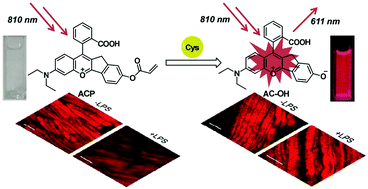A long wavelength emission two-photon fluorescent probe for highly selective detection of cysteine in living cells and an inflamed mouse model†
Abstract
As a semi-essential proteinogenic amino acid and biothiol, cysteine (Cys) is highly important in many basic cellular processes. Several two-photon (TP) fluorescent probes for Cys detection have been developed, but they are still far away from practical application due to the relatively short wavelength (<600 nm) and poor selectivity. To this end, enhancing the selectivity of TP probes for detecting Cys over other biological thiols is urgently demanded. Herein, we developed a long-wavelength emission TP activatable fluorescent probe (ACP) for detecting Cys with high sensitivity utilizing the hydroxyl protection/deprotection strategy, in which ACP can preferentially react with Cys to form a red-emitting anthocyanidin derivative fluorophore. TP fluorescence imaging of Cys with ACP at the cellular and tissue levels has been successfully carried out with excellent tissue penetration. More importantly, the fluctuation of Cys in an endotoxin lipopolysaccharide (LPS) induced oxidative stress mouse model could also be successfully visualized. Therefore, ACP has shown great potential to investigate the roles of Cys in biological and medical studies.



 Please wait while we load your content...
Please wait while we load your content...